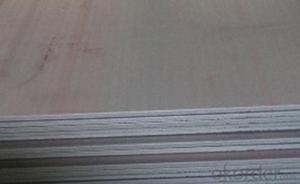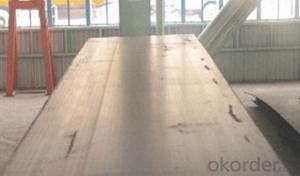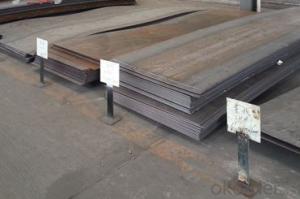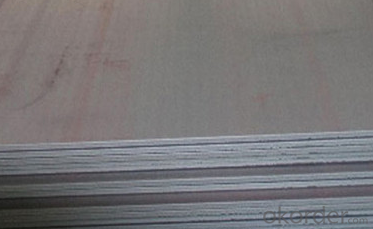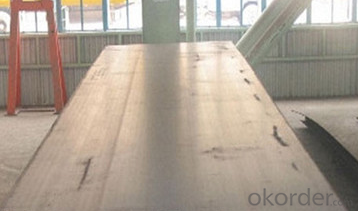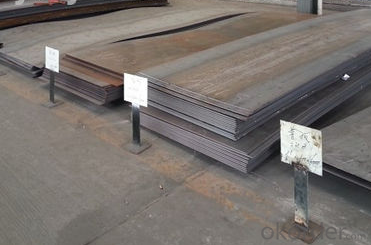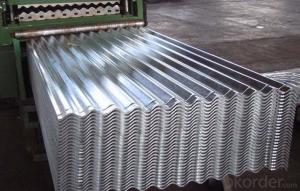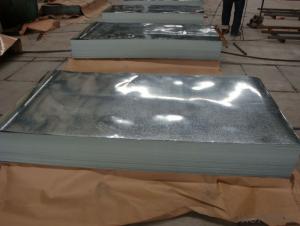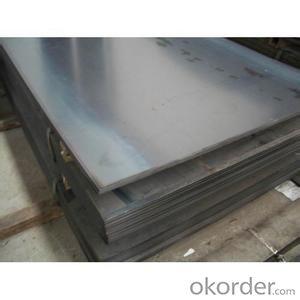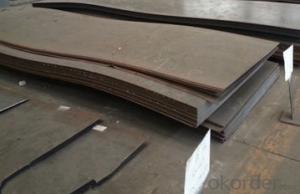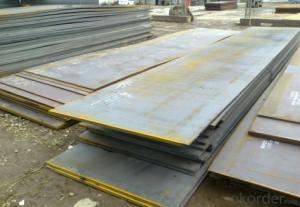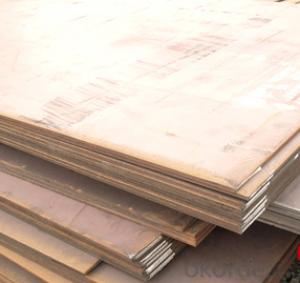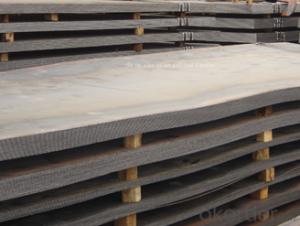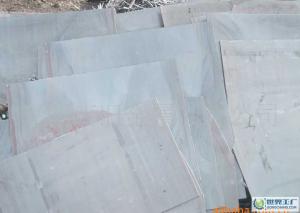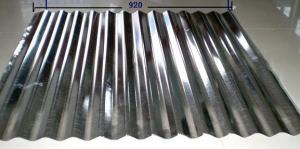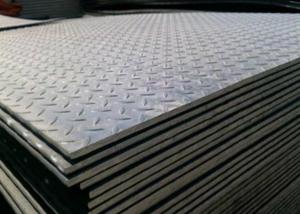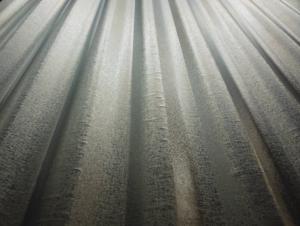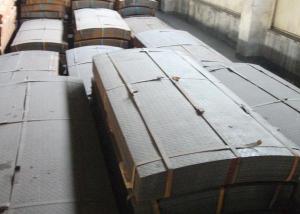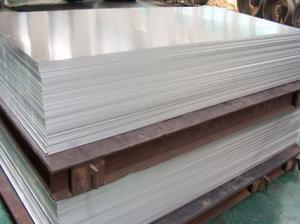Hot Rolled Carbon Steel Sheet A710 CNBM
- Loading Port:
- Qingdao
- Payment Terms:
- TT OR LC
- Min Order Qty:
- 10 pc
- Supply Capability:
- 30 pc/month
OKorder Service Pledge
Quality Product, Order Online Tracking, Timely Delivery
OKorder Financial Service
Credit Rating, Credit Services, Credit Purchasing
You Might Also Like
Quick Details
| Standard: | AISI, ASTM, DIN, GB, JIS | Grade: | A572,A573,A633,A678,A709,A710,G3101,G3136,etc | Thickness: | 1mm-200mm |
| Brand Name: | SHOU GANG GROUP, AN STEEL | Model Number: | Q235 | ||
| Type: | Steel Plate | Technique: | Hot Rolled | Surface Treatment: | Coated |
| Application: | widely | Special Use: | High-strength Steel Plate | Width: | 1000mm-3000mm |
| Length: | 1000mm-12000mm | Price Term: | FOB CIF CFR |
Packaging & Delivery
| Packaging Details: | standard seaworthy export packing or as the request of customers |
| Delivery Detail: | 10 days after deposit or according to customers' quantity |
Specifications
hot rolled carbon steel sheet
1.Thickness:1mm-200mm
2.Length:1000mm-12000mm
3.Width:1000mm-2000mm
hot rolled carbon steel sheet
| Product | HR steel plate prices carbon steel plate prices per kg |
| MOQ | 25 ton |
| Thickness | 1mm-200mm |
| Width | 1000mm-3000mm |
| Length | 1000mm-12000mm |
| Application | widely |
| Standard | AISI,ASTM,BS,DIN,JIS,GB,etc |
| Grade | A572,A573,A633,A678,A709,A710,G3101,G3136,etc |
| Tpye | Steel plate |
| Surfacing | Coated |
| Productive Technology | Hot Rolled & Cold Rolled |
| Port | |
| Payment Terms | L/C,T/T,Western Union,MoneyGram |
| Product Ability | 5000 tons per month |
| Delivery | 10 days after deposit or according to customers' quantity |
| Packing | standard seaworthy export packing or as the request of customers |
- Q: Can steel sheets be used in the construction of bridges?
- Indeed, the utilization of steel sheets in the construction of bridges is possible. Due to its numerous beneficial characteristics, steel has become a prevalent material in bridge construction. Owing to their exceptional strength and durability, steel sheets are well-suited for enduring substantial loads and adverse weather conditions. Furthermore, their flexibility facilitates simpler fabrication and installation processes. Moreover, the ease with which steel sheets can be welded or bolted together makes them highly suitable for the construction of expansive structures such as bridges. In conclusion, steel sheets provide a dependable and cost-effective solution for bridge construction.
- Q: Can the steel sheets be used in harsh environments?
- Yes, steel sheets can be used in harsh environments. Steel is known for its durability, strength, and resistance to various environmental factors such as extreme temperatures, moisture, corrosion, and chemical exposure. Therefore, steel sheets are often utilized in industries and applications that require materials capable of withstanding harsh conditions.
- Q: What is the corrosion resistance of steel sheets?
- The corrosion resistance of steel sheets depends on the type of steel and its composition. Generally, stainless steel sheets offer excellent corrosion resistance due to the presence of chromium, which forms a protective oxide layer. However, carbon steel sheets are more prone to rust and require additional measures like coatings or galvanization for improved corrosion resistance.
- Q: Can the steel sheets be used for magnetic shielding?
- Yes, steel sheets can be used for magnetic shielding. Steel is a ferromagnetic material, which means it can effectively redirect and absorb magnetic fields. When steel sheets are used to shield against magnetic fields, they create a barrier that helps to prevent the penetration of magnetic flux into a designated area. This property makes steel sheets an excellent choice for applications where magnetic shielding is required, such as in electronics, medical devices, and sensitive laboratory equipment. However, the effectiveness of steel sheets for magnetic shielding can depend on various factors, including the thickness and composition of the steel, as well as the strength and frequency of the magnetic field being shielded. Therefore, it is important to consider these factors and consult with experts to ensure the appropriate steel sheets are selected for optimal magnetic shielding.
- Q: How do steel sheets perform in electrical resistance?
- Steel sheets have high electrical resistance, meaning they are not good conductors of electricity.
- Q: Are steel sheets resistant to abrasion?
- Yes, steel sheets are generally resistant to abrasion. They are known for their durability and ability to withstand wear and tear, making them suitable for applications where abrasion resistance is required.
- Q: What is the typical impact resistance of a steel sheet?
- The typical impact resistance of a steel sheet varies depending on the specific grade and thickness of the steel. However, steel sheets are known for their high impact resistance compared to other materials. They can withstand substantial force without breaking or deforming, making them suitable for applications requiring durability and protection against impacts.
- Q: What are the different sheet metal cutting techniques for steel sheets?
- Steel sheets can be cut using various techniques, specifically designed for this purpose. Here are some commonly employed methods: 1. Shearing: By applying a high force, a shear or a pair of blades is used to cut the steel sheet. This method is ideal for straight cuts and works with both thin and thick steel sheets. 2. Laser cutting: A high-powered laser beam is employed to slice through the steel sheet. This technique offers high precision and allows for intricate designs. It is suitable for thin and thick steel sheets. 3. Plasma cutting: Here, a plasma torch generates an electrically conductive jet of plasma to cut through the steel. This method is commonly used for thick steel sheets and provides fast cutting speeds. 4. Waterjet cutting: The steel sheet is cut using a high-pressure jet of water mixed with abrasive particles. Waterjet cutting is versatile and can handle different thicknesses of steel sheets. It is also suitable for cutting heat-sensitive materials. 5. Punching: A punch and die set are used to create holes or various shapes in the steel sheet. Punching is a cost-effective method for repetitive cuts and can be used with thin and thick steel sheets. 6. Abrasive cutting: Thin steel sheets can be ground through using an abrasive wheel or disc. This technique provides a smooth finish. Factors such as the steel sheet's thickness, required precision, design complexity, and material heat sensitivity determine the choice of cutting technique. Each method has its own advantages and limitations, so it is crucial to take these factors into account when selecting the appropriate method for cutting steel sheets.
- Q: Can steel sheets be used for solar panel mounting?
- Yes, steel sheets can be used for solar panel mounting. Steel is a durable and strong material that can provide the necessary support for solar panels. It can be used as a reliable base for secure and stable installation, ensuring the longevity and stability of the solar panel system.
- Q: Can steel sheets be used for conveyor belts?
- Certainly! Conveyor belts can indeed utilize steel sheets. Steel, known for its versatility and durability, is capable of withstanding substantial weights and elevated temperatures, rendering it suitable for the purpose of conveyor belts. By manipulating steel sheets into different forms and dimensions, customization can be achieved to meet the precise demands of individual conveyor systems. Furthermore, steel sheets possess exceptional resistance against wear, impacts, and corrosion, guaranteeing an extended lifespan for the conveyor belt. All in all, steel sheets offer a dependable and sturdy solution for conveyor belt applications across industries such as manufacturing, mining, and logistics.
Send your message to us
Hot Rolled Carbon Steel Sheet A710 CNBM
- Loading Port:
- Qingdao
- Payment Terms:
- TT OR LC
- Min Order Qty:
- 10 pc
- Supply Capability:
- 30 pc/month
OKorder Service Pledge
Quality Product, Order Online Tracking, Timely Delivery
OKorder Financial Service
Credit Rating, Credit Services, Credit Purchasing
Similar products
Hot products
Hot Searches
Related keywords
